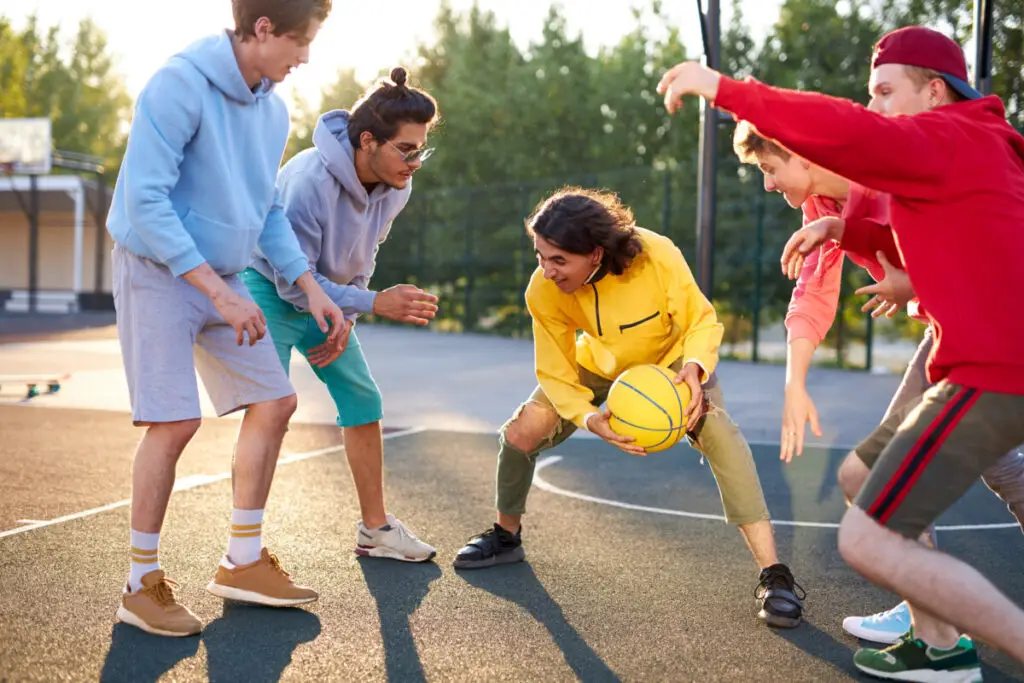
Every kid who has ever taken gym class has probably wondered why the basketball hoop is so high up. When you’re small, scrawny, and uncoordinated, the basketball hoop looks like it was made for giants, not you. So, who started it, and why is it up so high?
The Basketball hoop is 10 feet tall because James Naismith, who invented basketball in 1891, started the game by nailing peach baskets to the railing of the Springfield, Massachusetts YMCA running track. Those railings and baskets were 10 feet tall, and the tradition stuck.
It’s that simple! One man nails some peach baskets to a railing so he can toss a soccer ball (yes, really a soccer ball) into it with his friends, and now we have a sport that’s beloved worldwide. Keep reading to find out more about the weird and wonderful history of basketball.
The Original Game
James Naismith had a problem. He was a 30-year-old Canadian graduate student who had recently been appointed as a Physical Education teacher. He worked at the International Young Men’s Christian Association (YMCA) Training School, and a blizzard had just blown through town. He and his fellow teachers found themselves in charge of too many young men with serious cabin fever.
In spite of all their best efforts, including trying to fit a game of football into the school gym, nothing could quiet the boys down. They were bored and cramped. A fellow teacher challenged Naismith to make a new game that would keep them busy, and Naismith went to work.
He borrowed a couple of peach baskets from a janitor at the school, nailed them ten feet off the ground, and cleared out the gym before calling the boys in to play. After dividing the boys into two teams of nine, he gave them the singular rule of getting a soccer ball into the opposing team’s peach basket.

That went about as well as you might expect. One boy was knocked out, another’s shoulder was dislocated, and several boys had black eyes. They loved the game and begged, nagged, and pleaded to play again.
Naismith agreed to let them play again after he made 13 new rules, including a rule that nobody could run with the ball. It could be batted or thrown from where it was caught, but the player had to stand where he’d caught the ball.
That stopped the boys from tackling or punching each other, and the game caught on fast. Naismith, ever practical, called it Basket Ball.
The height of the hoop is one of the only rules and traditions that has not changed from that original game! A soccer ball was traded out for a new type of ball, peach baskets were replaced by iron hoops with nets, and a whatever-works approach to team size was replaced by five-player squads. The original 13 Rules of Basketball have been replaced by The National Basketball Association’s Official Rule Book, which is over 65 pages long and includes a section for Instant Video Replay.
Exceptions to the 10 Foot Height Rule
There are exceptions to the height rule, and they’re based on the age of the player. Some of the other rules will also change based on age to make sure the game stays playable.
- Basketball players 12 years and older play with the standard hoop height of 10 feet. This applies everywhere, from practice to competitions.
- Basketball players ages 11-12 use a standard hoop height of 9 feet
- Basketball players ages 8-10 use a standard hoop height of 8 feet
- Our youngest official players, ages 6-7 and under, use a standard height of 6 feet
There are no other official exceptions to the height rule, but parents can always adjust their backyard hoops to the appropriate height for their little children. Toy basketball hoops for ages 1.5-5 are a fun introduction to the game, and they keep to the original basketball spirit of keeping kids active and occupied.
Debate about Raising the Hoop Height
“Debate” is used very loosely here, as the likelihood of the NBA making a change is extremely low and few suggestions to change the standard height of a basketball hoop have been serious. Still, the conversation brings some interesting perspectives on how basketball has changed since its advent in 1891, altering nearly everything but the height of the hoop itself.
In a 2013 New York Times Op-Ed, legendary basketball coach Pete Newell suggested that the standard basketball hoop height change from 10 feet to 11 feet. He tested the idea himself for an exhibition game at the University of Washington, hoping to start a conversation for everyone in Organized Basketball. The experiment was a hit with fans, players, and the media, and even the NBA and FIBA were interested.
Newell expressed that, as a basketball purist, it bothered him to see a lack of skill in passing, spacing, cutting, shooting, and setting screens, with technique losing out in favor of showy individual plays. He said that he’d like to see the game return to a true team sport and that it would hardly be the first time a rule or regulation was adjusted to work with a modern game. He made the case that raising the hoop by one foot would force players to return to that classic team play and a focus on technique over a fancy show.

Responses to the Op-Ed were varied. Some loved the idea of a new challenge in the game, while others hated the idea for the same reason. Whatever their opinion, the debate around hoop height seems to be centered in the US and remains casual.
Reasons that were given for changing the height included:
- To make the game more challenging
- To encourage team play
- To revive interest in the game
- The average height of players has raised from 5’6 in 1891 to 6’7 in 2013
- Currently, many players can reach the hoop while standing below it
- The game is becoming repetitive and boring
- 10 feet tall is too easy
Reasons that were given against changing the height included:
- Simple tradition, since the height of the hoop is one of the few things that has never changed
- The game is fundamentally sound
- Existing infrastructure is extensive
- Many fans love watching players dunk the ball
- Players love dunking the ball
- Players who have practiced for their whole career to make a 10′ height would need to adjust every shot
- It would take 20 years or more for kids to adjust to a new height
- The adjustment period as a whole would be too painful and prolonged for basketball to survive
At this point in the height-changing conversation, it looks like the ten-foot-hoop is safe. James Naismith’s Peach Basket legacy is safe.
What Happens if the Hoop Height Is Off?
Too Low
What happens when the hoop is too low? This answer is simple. As anyone who has beaten a younger sibling with a game of driveway basketball can tell you, playing with a hoop that is too low makes the game too easy. Continuous practice with a short hoop could degrade skills and bring bad habits for a game with a regulation hoop, leaving you at a disadvantage when you’re in a regulation game.
Too High
Well, what about if the hoop is too high? The same concept applies here as well. If the hoop is too high for a growing child, they may develop bad throwing habits for later in life. This is why NBA height regulation exceptions are based on the age of the youth teams.
Where to Practice with a Regulation Hoop?

If you want to play basketball and you have a passion for accuracy, you might want something more than your home driveway and a peach basket.
Some places you might try looking on your search for a 10-foot tall hoop are:
- The local park, which may not have a true court but often has a regulation hoop
- A church gym, which may also have a basketball court or even a community basketball night
- Grade Schools in the community, though there are likely rules around who can use these/when they can be used
- A local university which may allow community access
- Community Centers
- Recreation Centers
A great resource is the website Let’s Go Ball, which was designed with the goal of helping people find places to play basketball in their own communities. Put in your zip code or city, and you should have a place to play!
Where to Buy a Regulation Hoop to Practice at Home?
If you’re short on community access to a basketball hoop, you might decide to set your basketball hoop up at home, instead. This is a great idea if you or your kids love playing, or if you just want to exercise! You don’t need a full-court setup to get better at shooting hoops, so you have a lot of flexibility.
Here are some good places to find a regulation height basketball hoop:
| Type of Store | Examples: |
|---|---|
| Sporting Goods Stores | |
| Major Retailers | |
| Online Retailers | |
| School Supply Stores | |
| Basketball Specialty Stores |
Keep in mind that each of those price points represents different qualities in the hoop! Some of them are fixed in the ground permanently, some are adjustable, some are portable, some have warranties and some do not. Your purchase should reflect your current needs, so don’t be afraid to buy a simple system if you’re keeping your backyard games casual.
Websites like Goalrilla have buying guides to help you decide on the hoop that’s best for you. This is a great option for first-time buyers who might be overwhelmed by the sheer volume of choices and who could use the advice of professionals. After all, what basketball fan doesn’t love a good coach?
Remember that you’ll need to regulate the space around the hoop if the 10-foot height accuracy is something you want to keep. A sloping driveway will throw off your shot. You might consider creating a concrete patio or strip that is long enough to allow you to get accurate practice, or placing the basketball hoop in the flattest area of your street or yard. Check the hoop with a tape measure to ensure you’ve set your hoop up to reach 10 feet at the top of the rim.
Once you’re set up for success, you can focus on having fun and dunking on your neighbors. After all, it’s your home court!
Does a Regulation Hoop Matter if I Just Want to Exercise?
The short answer here is, no, not really. If you have no plans of ever playing competitively and you aren’t going to confuse any neighborhood children with an inexact height, you can play any way you want. Having fun playing basketball is the most important part.
You could even take a page out of tradition’s book and nail a basket to your fence! Everyone who passed by could get a crash-course lesson in the history of basketball and how it transformed from one tired teacher’s snow-day idea into the worldwide phenomenon it is today.
The Inherited Basket
Maybe you moved into a house that had a basketball hoop on the property. Maybe a relative or neighbor had an old hoop in their yard and passed it on to you. It doesn’t quite look right, the net is missing, but what do you have to lose? Make sure the area is clear of any ankle-breaking damage and enjoy your inherited basketball hoop!
The Trash Can
Going to work doesn’t need to stop you from perfecting your shot! Relive your grade-school glory days of getting a balled-up wad of trash into the can with “Nothing but Net” without spending a cent. For an extra challenge, clear out the can and use an actual ball! Remember, the original game of basketball was created for teenage boys with cabin fever. Your boredom-based exercise is honoring the spirit of the game.

The Throwback Basket
Find a basket and nail it to a fence! You can even measure to make sure the rim is ten feet high. If you really want to make it authentic, play the game with a soccer ball and look up those 13 Rules of Basketball to share with your friends. This version of the game can be played anywhere in the world, on almost any size of court, with any number of players. James Naismith would be proud.
